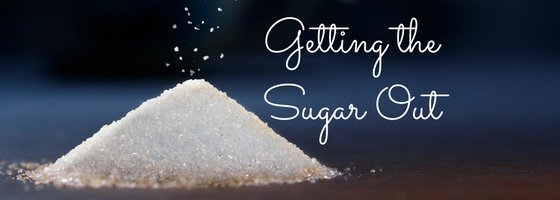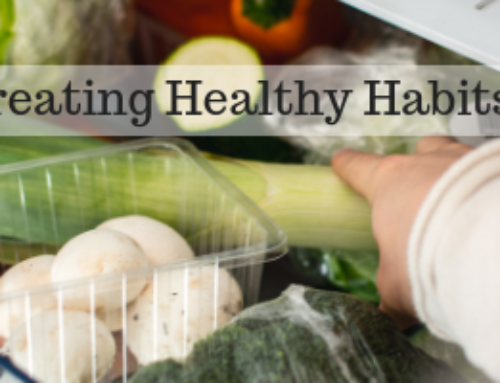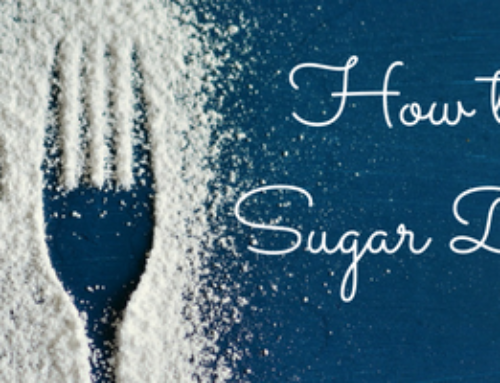Getting sugar out of your diet can be one of the most important nutritional steps you can take to better health. I’m talking about added sugars here, not the natural sugars that are found in foods like fruit or plain yogurt. But finding where those added sugars lurk can take some knowledge, and a little detective work. Let’s face it, sugar has been added to our food system, mainly in processed foods, in alarming quantities over the past few decades. Even in packaged foods you might consider healthy, sugar is often added — fruit flavored yogurt is a perfect example. Or foods you don’t think have added sugar, like salad dressings, yep, it can be there too! Let’s take a closer look.
Sugar is by far the most widely used food additive. Americans consume an impressive amount of it–on average, 133 pounds per person every year, mainly in the form of refined sugar through fructose and sucrose. This means that a shocking 25% of the average American’s daily intake of calories is in sugar of one form or another. The sugars naturally present in fruits, vegetables, and dairy products account for one-quarter of that; so roughly 18% of the average American’s daily caloric intake comes from added sugar and the sugars in processed foods, sweet desserts, candy, and soft drinks.
Even those who avoid desserts and maybe use artificial sweeteners in their coffee will probably come close to consuming about 30 teaspoons of sugar on a daily basis. That’s because everything from salad dressings to cereals contain sugar–added in processing or occurring naturally. In fact, if you take a few minutes to check the ingredients listed on any processed foods that you buy, you’ll probably find most of these foods contain “hidden” sugar–crackers, ketchup, bread, cereals, peanut butter, spaghetti sauce, soups, not to mention the more obvious sweet cookies, cake, ice cream, soda, and candy. Many of us have become so accustomed to the taste of sugar in our processed foods that we no longer consider them sweet. A hamburger with ketchup, for example, is not typically thought of as being sweet. But every tablespoon of ketchup contains a teaspoon of sugar. Most of us wouldn’t drink an eight-ounce glass of water with an added six teaspoons of sugar, which is the approximate amount of sugar added to some sodas.
For years, sugar has had a bad reputation as a junk food devoid of nutrients and an indulgence that contributes to extra pounds on the scale. More recently, however, scientific evidence has implicated sugar as a factor in heart disease, diabetes, obesity, dental decay, behavioral problems, obesity and problems with the immune system. The good news is that from a nutritional standpoint, we needn’t eat any sugar at all.
Sugar comes in many forms, and because not all are called “sugar,” they can easily be overlooked on a package label. Whether the sugar is refined white granulated table sugar or a sugar from a so-called “natural” source, a sugar is a sugar and our bodies do not know the difference.
The sugars discussed below share three basic characteristics: 1) They all provide 4 calories per gram. 2) With the exception of molasses (which contains some calcium and iron), they have no nutritional value (except for calories). 3) The negative effects appear to be the same no matter which sugar you consume. Note that many sugars have the suffix -ose.
It is very important to learn to read ingredient labels on any food product that comes in a package. Search for any added sugars that may be listed. You might be surprised how often they appear. Even if you think it is healthy, read the label. I, myself, have been fooled by the front of the packaging, not reading the ingredient label, only to get home and see the food I purchased is full of sugar. Here is a primer on sugars; it is by no means an exhaustive list. Be on the watch for these sugars added to foods you purchase.
Sucrose: Best known as white table sugar, sucrose is refined, usually from sugar cane or beets. Made up of equal portions of glucose and fructose, it is the most abundant sugar found in plants. It is also the sugar of raw sugar, turbinado (partially refined sugar), brown sugar, and confectioners’ (powdered) sugar.
Glucose (dextrose): The main sugar in the blood and a fuel for the body. But you do not have to eat any sugar to supply your body with glucose. Glucose can also be derived from the breakdown of protein or fat in some circumstances.
Fructose: The sugar in fruit and fruit juices is primarily fructose. (Most fruit actually contain a combination of fructose, glucose, and sucrose. Sucrose, however, is the main sugar in melons, oranges and peaches). It is the sweetest of the most commonly used sugars, about 70% sweeter than sucrose. It is, of course, better to get your sugar from fruit than from cookies or soda, since fruit comes with vitamins, minerals, and fiber. High fructose corn syrup contains fructose, and is widely used in commercial products.
Fruit juice concentrate: Basically, fruit juice that has been concentrated. Although, it comes from fruit, it is still sugar, and acts in your body as such.
Honey: A natural syrup made primarily of more fructose than glucose, and smaller amounts of maltose and sucrose. Honey can raise blood sugar levels more than sucrose. It also provides minuscule amounts of potassium, calcium, and phosphorus, which are present in such small amounts that they have little significance to human nutrition. Honey can also cause dental decay faster than sucrose. Some types of honey have been found to cause botulism in infants.
Molasses: The thick syrup left over after the crystals of sucrose are removed from sugar cane or beet juice. It is made of a variety of sugars and contains small amounts of calcium, iron, B-vitamins and potassium. Iron is the major nutrient in molasses, which is mainly a contaminant from the machinery used in processing it.
Brown sugar: Is white sugar, or sucrose, colored with a small amount of molasses. Since it is about 95% pure sucrose, it offers no nutritional advantages over other types of sugar.
Raw sugar: Is partially refined sucrose. It is the residue left after sugarcane has been processed to remove the molasses and refine the sugar crystals. It is no more nutritious than white sugar.
Lactose: Also known as milk sugar, it is less sweet than sucrose.
Maltose: Is malt sugar, formed by the breakdown of starch, and is present in barley malt.
Corn syrup: Is a syrup made from cornstarch that is mostly glucose, and partly maltose.
High-fructose corn syrup: Made from corn starch, this syrup has its fructose content increased with enzymes. Sweeter than sucrose, it is now used to sweeten almost all regular soft drinks and added to packaged foods as a sweetener.
Maple syrup or sugar: Derived from the sap of the sugar maple tree, maple sugar is a concentrated solution of sucrose. Although it was once a popular sweetener, this sugar is rarely added to processed foods and has mostly been replaced by sucrose and artificial maple flavoring.
Thanks for reading! Look for future articles exploring this topic more. If you found this blog post helpful, please share with family and friends.
In Health,






